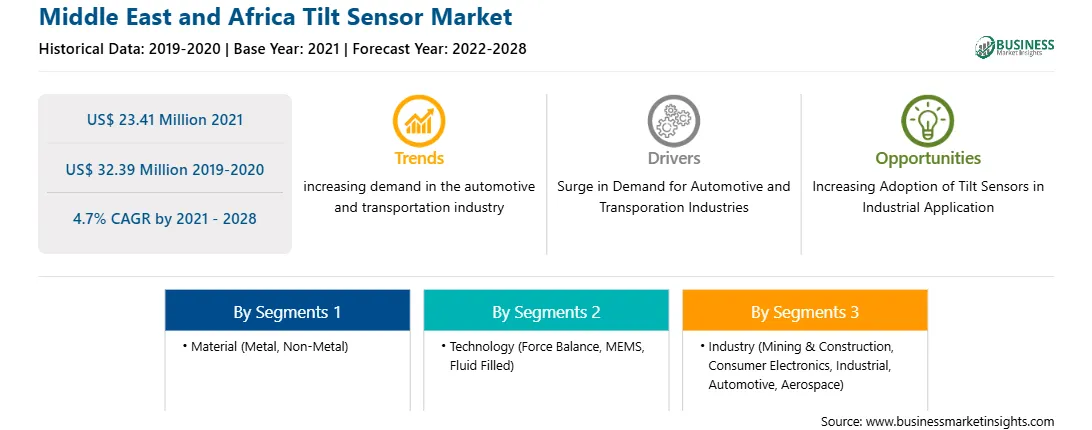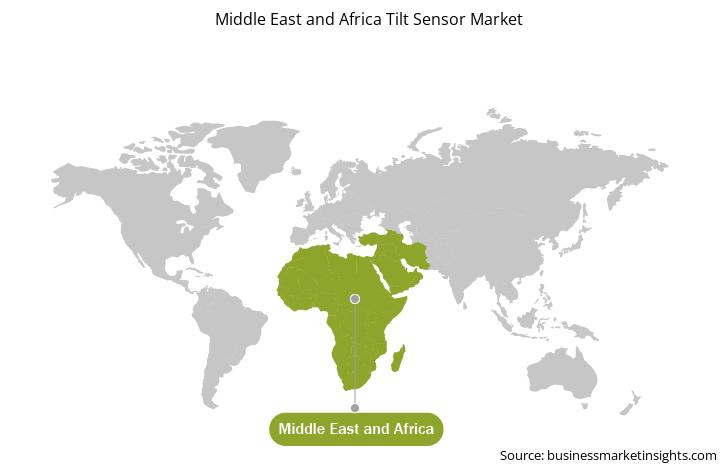2028 年中东和非洲倾斜传感器市场预测 - COVID-19 影响和区域分析,按材料 (金属和非金属) , 技术 (力平衡, MEMS 和流体填充) 和行业 (采矿和建筑, 消费电子, 工业, 汽车, 航空航天等)
No. of Pages: 103 | Report Code: TIPRE00028005 | Category: Electronics and Semiconductor
No. of Pages: 103 | Report Code: TIPRE00028005 | Category: Electronics and Semiconductor
推动市场增长的关键因素是采用率的不断提高工业应用以及汽车和运输领域的倾斜传感器。然而,基于力平衡技术的倾斜传感器的高成本可能会阻碍未来几年的市场发展。
对倾斜或倾角传感器的需求正在增长在汽车行业。这些与陀螺仪一起主要用于提高乘客安全和车辆效率。倾斜传感器用于各种车辆应用,包括电子驻车制动器、侧翻检测、电子稳定性控制和怠速停止启动等。此外,随着汽车公司增加对车辆自动化的投资,ADAS 和惯性导航、坡道起步辅助和动态前灯调平的使用也在增加。例如,梅赛德斯制造了能够适应道路倾斜曲线的自动调平灯。该组织还为此自动化安装了倾斜传感器。
此外,汽车行业在开发自动驾驶车辆方面正在取得进展。近年来,这些汽车的开发和使用急剧增加。例如,宝马于 2019 年 3 月开始在其新工厂生产自动驾驶电动汽车。据瑞银预测,到 2030 年,自动驾驶汽车的生产和销售收入预计将达到 2,430 亿美元。
预计在预测期内将继续对这些技术进行更多投资和增长计划,这预计将创造行业对倾斜传感器的需求。
MEA 倾斜传感器市场主要是受到供应链中断的影响。由于各国关闭边境,一些零部件的供应链受到干扰。自 MEA 国家爆发 COVID-19 以来,对传感器系统和传感器的需求有所减弱。这导致向该地区各个行业提供产品的传感器系统和传感器制造商业务损失。
拥有较高制造单位的国家,例如土耳其、以色列、和南非,见证了采购各种电子和半导体产品的关键场景,其中包括显示该地区 MEA 倾斜传感器市场下滑的传感器。
南非的建设活动该地区属于快速增长的行业之一。阿联酋、沙特阿拉伯和卡塔尔是海湾合作委员会建筑业的先行者。 COVID-19病毒的爆发已暂停了上述国家的多项建筑活动,其中一些项目仍可能继续暂停。该参数是对传感器系统行业产生负面影响并随后损害倾斜传感器市场的关键因素之一。
环境政策的发展、新技术的引入以及消费者对所有权的态度转变正在导致中东经济发生重大变化。几乎每个行业都因新的商业模式、自动化程度的提高和数字化而发生了转变,汽车行业也不例外。由于这些原因,汽车行业出现了一些颠覆性的技术驱动趋势,包括自动驾驶、电气化、多元化出行和互联化。如今,该行业已准备好迎接中东的颠覆,大多数参与者相信,最近的趋势将获得牵引力并相互加强。这些因素可能有助于 MEA 倾斜传感器市场在疫情后复苏。
Strategic insights for Middle East and Africa Tilt Sensor involve closely monitoring industry trends, consumer behaviours, and competitor actions to identify opportunities for growth. By leveraging data analytics, businesses can anticipate market shifts and make informed decisions that align with evolving customer needs. Understanding these dynamics helps companies adjust their strategies proactively, enhance customer engagement, and strengthen their competitive edge. Building strong relationships with stakeholders and staying agile in response to changes ensures long-term success in any market.

| Report Attribute | Details |
|---|---|
| Market size in 2021 | US$ 23.41 Million |
| Market Size by 2028 | US$ 32.39 Million |
| Global CAGR (2021 - 2028) | 4.7% |
| Historical Data | 2019-2020 |
| Forecast period | 2022-2028 |
| Segments Covered |
By 材质
|
| Regions and Countries Covered | 中东和非洲
|
| Market leaders and key company profiles |
The regional scope of Middle East and Africa Tilt Sensor refers to the geographical area in which a business operates and competes. Understanding regional nuances, such as local consumer preferences, economic conditions, and regulatory environments, is crucial for tailoring strategies to specific markets. Businesses can expand their reach by identifying underserved regions or adapting their offerings to meet regional demands. A clear regional focus allows for more effective resource allocation, targeted marketing, and better positioning against local competitors, ultimately driving growth in those specific areas.

The Middle East and Africa Tilt Sensor Market is valued at US$ 23.41 Million in 2021, it is projected to reach US$ 32.39 Million by 2028.
As per our report Middle East and Africa Tilt Sensor Market, the market size is valued at US$ 23.41 Million in 2021, projecting it to reach US$ 32.39 Million by 2028. This translates to a CAGR of approximately 4.7% during the forecast period.
The Middle East and Africa Tilt Sensor Market report typically cover these key segments-
The historic period, base year, and forecast period can vary slightly depending on the specific market research report. However, for the Middle East and Africa Tilt Sensor Market report:
The Middle East and Africa Tilt Sensor Market is populated by several key players, each contributing to its growth and innovation. Some of the major players include:
The Middle East and Africa Tilt Sensor Market report is valuable for diverse stakeholders, including:
Essentially, anyone involved in or considering involvement in the Middle East and Africa Tilt Sensor Market value chain can benefit from the information contained in a comprehensive market report.